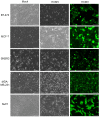Productive Infection of Human Breast Cancer Cell Lines with Human Cytomegalovirus (HCMV)
- PMID: 34070980
- PMCID: PMC8224681
- DOI: 10.3390/pathogens10060641
Productive Infection of Human Breast Cancer Cell Lines with Human Cytomegalovirus (HCMV)
Abstract
Breast cancer is the leading cause of cancer deaths among women worldwide. There are many known risk factors for breast cancer, but the role of infectious disease remains unclear. Human cytomegalovirus (HCMV) is a widespread herpesvirus that usually causes little disease. Because HCMV has been detected in breast tumor biopsy samples and is frequently transmitted via human breast milk, we investigated HCMV replication in breast tumor cells. Four human breast cancer cell lines with different expression profiles for the key diagnostic markers of the estrogen receptor (ER), progesterone receptor (PR), and human epidermal growth factor receptor 2 (HER2), were infected with a bacterial artificial chromosome-derived HCMV clinical strain TB40/E tagged with green fluorescent protein (GFP). Fluorescence microscopy confirmed that all four breast cancer cell lines supported virus entry. RNA was isolated from infected cells and the expression of immediate early (UL123), early (UL54), and late (UL111A) genes was confirmed using PCR. Viral proteins were detected by immunoblotting, and viral progeny were produced during the infection of breast tumor cells, as evidenced by subsequent infection of fibroblasts with culture supernatants. These results demonstrate that breast tumor cells support productive HCMV infection and could indicate that HCMV replication may play a role in breast cancer progression.
Keywords: HCMV; breast cancer; cancer; cytomegalovirus.
Conflict of interest statement
The authors declare no conflict of interest. The funders had no role in the design of the study; in the collection, analyses, or interpretation of data; in the writing of the manuscript, or in the decision to publish the results.
Figures




References
Grants and funding
LinkOut - more resources
Full Text Sources
Research Materials
Miscellaneous

